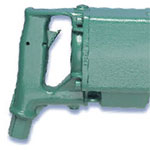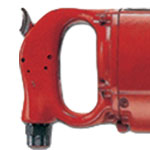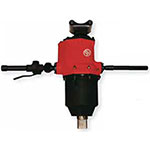
Impact Wrench Information
The following is a collection of generalized product knowledge regarding impact wrenches, covering features and trends common to wrenches made by most manufacturers. By the time you reach the bottom of this page, you should have a much better understanding of the purpose, construction, and impact mechanisms shared by most impact wrenches.
At mdi, our Product Experts are committed to maintaining practical, up-to-date knowledge on all of the products we offer. We believe that knowledge empowers us to make the best decisions.
As part of our dedication to excellent customer service, we freely extend our knowledge to you.
Use the Table of Contents below to move more quickly about the page.
What is an impact wrench?

An impact wrench (also commonly referred to as an impactor or impact gun) is a socket wrench power tool that stores kinetic energy through a spinning weight (called the hammer) before releasing that energy as a sudden torque by striking an output shaft (called the anvil).
The purpose of these tools is to minimize operator effort and increase productivity in tightening or loosening stubborn nuts, bolts, and sometimes screws. They are most commonly employed in automotive mechanic shops, but can be used anywhere that bolts and fasteners are used, such as in construction.
How does it work?

Impact wrenches utilize a motor (commonly a pneumatic vane motor, though electric and hydraulic power sources are sometimes used) to spin a weighted device, called the hammer, before allowing it to strike the output shaft, called the anvil. The design of the mechanism is such that the hammer can then slip free from the anvil, spin, and strike again. Depending on the design of the mechanism, these blows occur once or twice per revolution, with a higher frequency of blows meaning less power as the hammer has less time between blows to accelerate.
This mechanism is only engaged after reaching a certain minimum resistance torque from the bolt or fastener; unless that minimum torque is satisfied, the hammer and anvil spin together, allowing quick run-down before tightening or quick removal after loosening.
Unlike an air ratchet that delivers constant torque, an impact wrench delivers a rapid series of blows that transfer energy into the bolt or fastener. The only effects felt by the operator are from the motor as it accelerates the hammer, thus lending to decreased operator fatigue despite the high peak output torque.
Furthermore, the rapid blows of an impact wrench make the tool ineffective against outputs that are "springy" and capable of absorbing the energy. Depending on the flexibility of the receiving medium, the absorption of the output energy will mean that virtually no torque is ever applied to the fastener, and may actually cause the wrench to turn backwards from reflecting the blows. Therefore, impact wrenches are most effective on nuts or bolts tightened into a very solid object. Some designs take advantage of torsion springs to shut off the wrench when a desired maximum torque is reached.
Despite any variation in specific designs, all impact wrenches accomplish the same thing: they allow the hammer to spin freely from the anvil, accelerate it to store kinetic energy, and transfer that energy to the anvil with a sudden blow before allowing the hammer to slip free and spin again.
What options are available?
Depending upon size, application, and personal preference, an impact wrench can be constructed in several different ways.
The most obvious difference is the divide between an inline wrench (where the handle and drive are in a straight line) and a pistol grip wrench (where the handle is at an approximate right angle to the body and drive, to be held like a pistol). These are generally dependent upon size, where the very small and very large wrenches tend to have an inline configuration while everything in between tends to have a pistol grip.
As the majority of the impact wrenches on the market (and that we offer for sale) are air-powered, we will focus on pneumatic impact wrenches for these examples. Although the pistol grip design is straightforward and operates much the same across all makes and models, pneumatic inline wrenches can have one of five distinct configurations that operate a bit differently from one another:

Lever throttle inline wrenches use a lever as the trigger mechanism. This design is commonly seen on other inline pneumatic tools, such as die grinders and drills. These are seen on wrenches with the lowest torque.

Butterfly inline wrenches have a throttle paddle parallel to the body on the top of the housing. Tilting this paddle one way or the other will operate the tool in forward and reverse, respectively, eliminating the need for a forward/reverse switch. These are seen on low torque wrenches.

D-handle wrenches with an interior trigger feature an enclosed, D-shaped handle on the back of the tool, with a trigger on the interior to be squeezed by the index finger. These are most commonly seen on medium- and high-torque wrenches.

D-handle wrenches with an exterior trigger are much the same as interior trigger D-handle wrenches, except the trigger is on the exterior of the handle, to be depressed by the operator’s thumb.

T-handle wrenches are the largest and most powerful of impact wrenches, featuring long handles that extend perpendicularly from either side of the wrench for maximum control and stability. These wrenches often have eyelets on the top of the housing to facilitate suspension from a crane or other device, as these wrenches are almost always too heavy for operators to lift by themselves. They can have maximum torque ratings from several thousand to several hundred thousand foot-pounds.
Some wrenches may be configured differently for spatial considerations, such as inline wrenches that use geared right-angle heads for the output drive. These wrenches can be used in situations where there is insufficient space for a traditional wrench.
A less obvious difference between impact wrenches is the clutch mechanism of the hammer and anvil. These are determined by the make and model of the wrench, but the design of the mechanisms themselves (for instance, the number of and design of parts in a pin type clutch) are shared by all wrenches that use them, regardless of the manufacturer. Common clutch mechanisms include pin, dog, rocking dog, jaw, and hammer.
The housing materials of impact wrenches can vary for specific applications or for operator comfort. Many traditional metal wrench housings now include a soft, synthetic grip for comfort and vibration absorption. Although steel or aluminum continue to be popular choices, many modern housings are also created using durable composite to reduce the tool’s weight. Heavier and more powerful pistol grip and D-handle wrenches include a second handle on the side of the tool for a more stable grip.
What is the best wrench for my application?
To determine the best fit for your application, answer the following questions:
- What is the size of the bolt/nut you need to tighten or remove?
- To what torque do you need to tighten the bolt/nut? AND/OR What is the breakaway torque needed to loosen the bolt/nut?
- Do you already have impact sockets? If so, do they use a square drive, or do they require a hexagonal or spline drive?
- Do you already know what type of clutch/hammer mechanism would work best for your application? (Hint: Do you need faster, softer impacts or slower, harder impacts?)
- Are there any concerns for your operator that might determine more ergonomic choices in your wrench?



